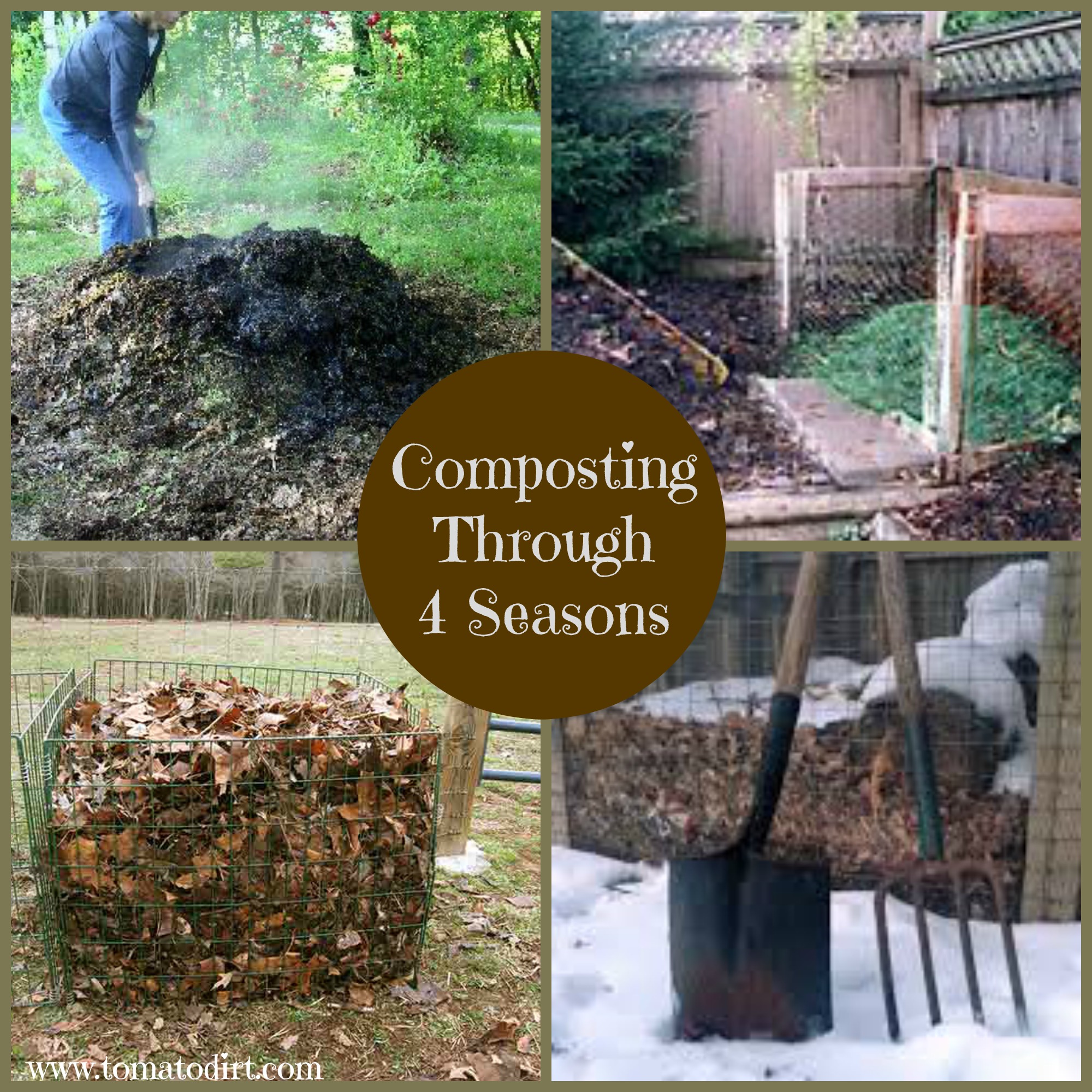FREE: 10 Must-Know Tomato Growing Tips Get The Guide
Read our affiliate disclosure here.
When to Compost: A Guide to Composting Through 4 Seasons
Since 2010, Tomato Dirt has garnered 4.8+ million views, making it the web’s leading online source for growing tomatoes in the home garden. Award-winning writer and Tomato Dirt owner Kathy Widenhouse has helped thousands of home gardeners grow healthier tomatoes. Be one of them when you get Tomato Dirt’s Growing Guide here.
Updated 9.16.24
When to compost? You may be surprised to learn that composting is a gardening activity you can and should do year round.
In fact, each season offers its own special composting benefits. Use this guide to find out how to compost during all four seasons of the year.
Composting in the Spring
Rising temperatures in the spring help raise the temperature in compost, whether in a bin, pile, or tumbler.
If you’ve already got a compost pile, then you’ll have added organic matter to it over the winter months.
The new material and the spring season’s rising temperatures are good news for the microorganisms in the pile. They feed on organic matter, which is best broken down when temperatures are between 140°F and 160°F. Your compost pile will start to cook naturally on its own as temperatures get warmer during the spring.
If you’re starting a new compost pile in the spring, then be sure to turn it regularly to allow air into its deeper pockets.
Some bins can create usable compost in as little as 21 days. That means you may be able to use your new compost during the early part of the growing season.
Composting in the Summer
Summer is also a great time for composting. The summer sun can help your pile to “cook,” giving it an extra boost.
If you have an established compost pile, then focus on maintenance during the summer. You can use this time of year to build your compost pile by adding good amounts of grass clippings. Remember to keep your pile or bin a little moist during the dry spells, or the composting process will start to slow down.
If you are just starting a compost pile in the summer, conditions provide the four elements needed to build healthy compost: food, water, air, and heat. Follow best practices for layering green and brown organic matter, sprinkling brown matter (like spent early crops and corn stalks) with green matter (grass clippings, fruit skins, vegetable scraps, and coffee grounds.) Be sure to periodically moisten the pile if rain is sporadic to provide water and turn it to allow good air circulation. Heat is a given.
Composting in the Fall
In the wake of summer growth, fall may be the best time to start composting. Collect your fall leaves to use in your compost pile, layering them with dead or dying flowers, spent tomato plants, grass clippings, and other garden debris as you tidy up the garden after the growing season. Alternate a layer of leaves to the compost pile with other organic material to prevent matting.
Whether your compost pile is new or established, reserve extra leaves in a separate pile or in a bag next to your compost bin. Use them during the winter as a brown layer in between “green” kitchen refuse.
Keep a tarp ready to spread over the pile during rainy spells to prevent the compost from becoming too soggy.
And don’t forget to turn your compost to let in air pockets! (Here are some tools to use to help you turn your compost.)
Composting in the Winter
You may notice that as temperatures drop, the composting process slows down too. But as long as the temperatures remain above freezing, composting continues. When the temperatures fall below freezing for several days, weeks, or months in a row, the process may come to a complete stop altogether. Microorganisms cannot continue to create compost until the temperatures rise. But never fear. Once temperatures rise, the microorganisms will automatically start the composting process again.
Bottom line: continue to add kitchen refuse to the pile over the cold months. Sprinkle a layer of dried leaves, saved from the fall, in between layers of kitchen scraps to continue the compost cooking process.
One significant plus for your compost pile in the winter: scatter wood ash from your fireplace or wood stove to the compost pile. Be sure to use a tarp to cover the compost pile during heavy rain or snow storms. (Here are some tarps to check out.)
If your bin or pile gets full during the winter, you may consider starting a new one in layers so it is ready to begin “cooking” as soon as temperatures start to warm in the spring.
More about Composting for Tomatoes
Composting basics to get you started ...
4 Types of Compost Bins: Which Is Best for You?
How to Compost Tomato Plants ...
Compost Containers For Outside: Which Is Right for You?
How to use a kitchen compost bin to make black gold ...
2 types of composting for the home gardener ...
Get more tips on our Compost for Tomatoes Pinterest Board...
Return from When to Compost to Tomato Dirt home
As an Amazon Associate and Rakuten Advertising affiliate I earn from qualifying purchases.
SHARE THIS PAGE:
FREE! 10 Must-Know Tomato Growing Tips: 20-page guide
Get yours here:





New! Comments
Have your say about what you just read! Leave a comment in the box below.